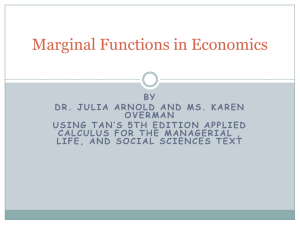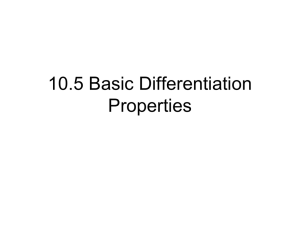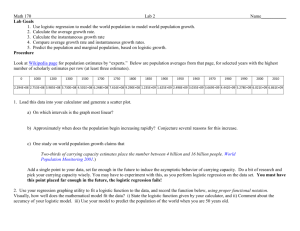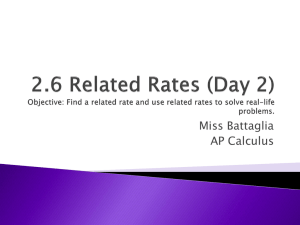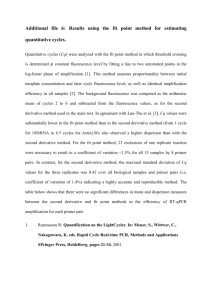Solutions for the CBD class Worksheets
advertisement
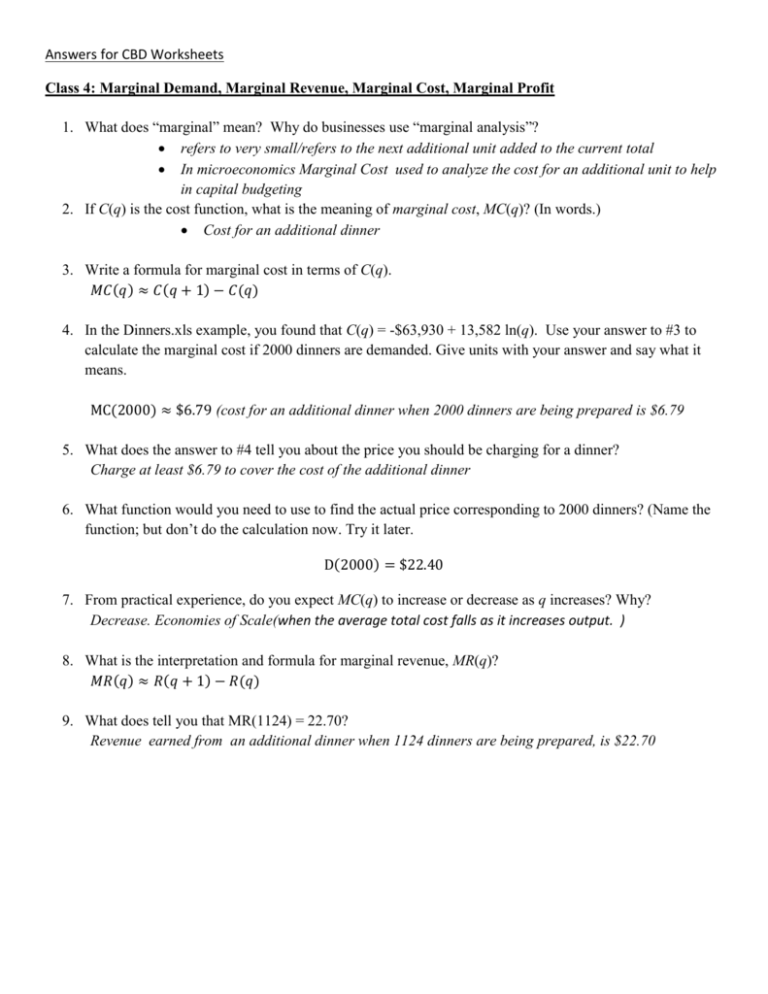
Answers for CBD Worksheets Class 4: Marginal Demand, Marginal Revenue, Marginal Cost, Marginal Profit 1. What does “marginal” mean? Why do businesses use “marginal analysis”? refers to very small/refers to the next additional unit added to the current total In microeconomics Marginal Cost used to analyze the cost for an additional unit to help in capital budgeting 2. If C(q) is the cost function, what is the meaning of marginal cost, MC(q)? (In words.) Cost for an additional dinner 3. Write a formula for marginal cost in terms of C(q). 𝑀𝐶(𝑞) ≈ 𝐶(𝑞 + 1) − 𝐶(𝑞) 4. In the Dinners.xls example, you found that C(q) = -$63,930 + 13,582 ln(q). Use your answer to #3 to calculate the marginal cost if 2000 dinners are demanded. Give units with your answer and say what it means. MC(2000) ≈ $6.79 (cost for an additional dinner when 2000 dinners are being prepared is $6.79 5. What does the answer to #4 tell you about the price you should be charging for a dinner? Charge at least $6.79 to cover the cost of the additional dinner 6. What function would you need to use to find the actual price corresponding to 2000 dinners? (Name the function; but don’t do the calculation now. Try it later. D(2000) = $22.40 7. From practical experience, do you expect MC(q) to increase or decrease as q increases? Why? Decrease. Economies of Scale(when the average total cost falls as it increases output. ) 8. What is the interpretation and formula for marginal revenue, MR(q)? 𝑀𝑅(𝑞) ≈ 𝑅(𝑞 + 1) − 𝑅(𝑞) 9. What does tell you that MR(1124) = 22.70? Revenue earned from an additional dinner when 1124 dinners are being prepared, is $22.70 10. If you had been selling 1124 dinners and started to sell more, would you be taking in more or less money than before? (Caution: You can’t assume that the price stays the same, as it will have decreased. Use your answer to #9.) More. Because a positive marginal revenue at 1124 means that revenue is increasing (Marginal revenue is the derivative of the revenue function) When revenue function is increasing->marginal revenue function is positive When revenue function is decreasing->marginal revenue function is negative 11. What is the interpretation and formula for marginal profit, MP(q)? 𝑀𝑃(𝑞) ≈ 𝑃(𝑞 + 1) − 𝑃(𝑞) 12. What does tell you that MP(1124) = 10.62? Do you want to increase or decrease the number of dinners you sell? Profit earned from an additional dinner when 1124 dinners are being prepared, is $10.62. Increase(because at 1124, profit is increasing). 13. What does tell you that MP(2124) = –1.82? Do you want to increase or decrease the number of dinners you sell? when 2124 dinners are being prepared, loss(negative profit)s from an additional dinner is $10.62. decrease(because at 2124, profit is decreasing). 14. Since P(q) = R(q) – C(q), we have MP(q) = MR(q) – MC(q), What does it tell you about profit if marginal revenue is more than marginal cost? (That is MR(q) > MC(q).) What should the company do? 𝑀𝑃(𝑞) > 0-> P(q) is increasing Make more Dinners 15. What does it tell you about profit if marginal revenue is less than marginal cost? (That is MR(q) < MC(q).) What should the company do? 𝑀𝑃(𝑞) < 0-> P(q) is decreasing Make less Dinners 16. Comparing your answers to #14 and 15, what is true about MR and MC when profit is a maximum? 𝑀𝑅(𝑞) = 𝑀𝐶(𝑞) & 𝑀𝑃(𝑞) should change sign from positive to negative Class 5: Marginality and the Derivative Open Dinners.xls at M Cost and M Profit pages 1. Review: What does “marginal profit” mean? Give definition and interpretation. 𝑀𝑃(𝑞) ≈ 𝑃(𝑞 + 1) − 𝑃(𝑞) Profit earned from an additional dinner 2. How do you visualize the marginal profit on the profit graph? The slope of the profit graph represents the marginal profit 3. Look at the profit graph. By hand, very roughly sketch a marginal profit graph. Profit Function $6,000 $4,000 P(q) $2,000 $0 -$2,000 0 1000 2000 3000 4000 3,000 4,000 -$4,000 -$6,000 q Marginal Profit Function $12 MP(q) $/dinner $8 $4 $0 0 1,000 2,000 -$4 -$8 -$12 q 4. Look at the cost graph. By hand, very roughly sketch a marginal cost graph. Cost Function $50,000 C(q) $40,000 $30,000 $20,000 $10,000 $0 0 1000 2000 q 3000 4000 Marginal Cost Function, Final Plan MC(q) $ /dinner $16 $12 $8 $4 $0 0 1,000 2,000 3,000 4,000 q dinners 5. Compare your answers to #4 with the graph shown. Why is the marginal cost function positive and decreasing everywhere? Marginal cost function is positive because the cost function is increasing Marginal cost function is decreasing because the slope of the cost function is decreasing 6. Compare your answers to #3 with the graph shown. What determines where the marginal profit function is positive? Negative? When profit function is increasing then marginal profit is positive When profit function is decreasing then marginal profit is negative 7. Still looking at your answer to #3. What about the marginal profit function shows where the profit function has a maximum? Profit maximum Marginal profit is zero. Left of that point the marginal profit should be positive & right of that point the marginal profit should be negative 8. From your answer to #3:. What about the marginal profit function shows that the profit function has a maximum, as opposed to a minimum? Profit minimum Marginal profit is zero. Left of that point the marginal profit should be negative & right of that point the marginal profit should be positive 9. How does the marginal profit function relate to the marginal cost and marginal revenue? 𝑀𝑃(𝑞) = 𝑀𝑅(𝑞) − 𝑀𝐶(𝑞) Definition of Derivative 10. How is f ‘(x), the derivative of f(x), defined? f ( x) f ( x h) f ( x ) h 11. How do you picture f ‘(x) on a graph of f(x)? The slope of f(x) represents the f ‘(x) 12. Open Example3.xls. How are the graphs of function and derivative related? The derivative represents the slope of the function The function (blue) is increasing everywhere- >the derivative is positive(graph above the x-axis) From − ∞ 𝑡𝑜 0 the slope of the function is decreasing(the derivative function is decreasing) From 0 𝑡𝑜 ∞ the the slope of the function is increasing At 0 the slope of the function is zero->the derivative function is zero Example 3: f(x) and f'(x) 40 function 30 derivative values 20 10 0 -3 -2 -1 -10 0 1 2 3 -20 x 13. Run Differentiating.xls on function in Example 3. What do you notice? The derivative of 𝑓(𝑥) = 𝑥 3 + 6 is 𝑓′(𝑥) = 3𝑥 2 The derivative of a cubic function is a 2nd degree polynomial FUNCTION & DERIVATIVE 1500 functi on 1000 500 f(x) f'(x) -15 0 -10 -5 -500 0 -1000 -1500 x 5 10 15 14. Run Differentiating.xls on function in f(x)=x2. What do you notice? What do think the formula is for f ‘(x)? The derivative of a 2nd degree polynomial function is a line 𝑓′(𝑥) = 2𝑥 FUNCTION & DERIVATIVE 1500 functi on 1000 500 f(x) f'(x) -15 0 -10 -5 -500 0 5 10 15 -1000 -1500 x 15. Run Differentiating.xls on function in f(x)=3. What is the formula for f ‘(x)? Why? The derivative of a horizontal line is 0 𝑓′(𝑥) = 0 f(x) f'(x) -20 f… FUNCTION & DERIVATIVE d… 1500 1000 500 0 -10 -500 0 10 20 -1000 -1500 x 16. Run Differentiating.xls on function in f(x)=3x. What do you notice? [Note: Only look at the combined graph at the bottom, not the derivative alone.] What do think the formula is for f ‘(x)? The derivative of a line with positive slope(3) is 3 𝑓′(𝑥) = 3 FUNCTION & DERIVATIVE 1500 functio n 1000 500 f(x) f'(x) -15 0 -10 -5 -500 0 -1000 -1500 x 5 10 15 17. Run Differentiating.xls on function in f(x)=x3. What do think the formula is for f ‘(x)? 𝑓′(𝑥) = 3𝑥 2 functi on FUNCTION & DERIVATIVE 1500 1000 500 f(x) f'(x) -15 0 -10 -5 -500 0 5 10 15 -1000 -1500 x 18. Summarize the derivative formulas we have. Function: f(x) = a f ‘(x) = 0 f(x) = x f ‘(x) = 1 f(x) =x2 f ‘(x) = 2x f(x) = 𝑥 𝑛 f ‘(x) = 𝑛𝑥 𝑛−1 Derivative: Class 6: Formulas for the Derivative 1. How much of this table can you fill in as a result of the last class? Fill that in. Function: Derivative: General Rules f(x) = a f ‘(x) = 𝑑 (𝑎𝑓(𝑥)) = 𝑑𝑥 f(x) = x f ‘(x) = 𝑑 (𝑓(𝑥) + 𝑔(𝑥)) = 𝑑𝑥 f(x) =x2 f ‘(x) = 𝑑 (𝑓(𝑥) ∙ 𝑔(𝑥)) = 𝑑𝑥 f(x) = x3 f ‘(x) = f(x) = xn f ‘(x) = f(x) =esx f ‘(x) = f(x) = ln(x) f ‘(x) = Derivative Formulas(Answers) Function: Derivative: General Rules f(x) = a f ‘(x) = 0 𝑑 (𝑎𝑓(𝑥)) = 𝑎𝑓 ′ (𝑥) 𝑑𝑥 f(x) = x f ‘(x) = 1 𝑑 (𝑓(𝑥) + 𝑔(𝑥)) = 𝑓"(𝑥) + 𝑔′(𝑥) 𝑑𝑥 f(x) =x2 f ‘(x) = 2x 𝑑 (𝑓(𝑥) ∙ 𝑔(𝑥)) = 𝑓 ′ (𝑥)𝑔(𝑥) + 𝑓(𝑥)𝑔′ (𝑥) 𝑑𝑥 f(x) = 𝑥 𝑛 f ‘(x) = 𝑛𝑥 𝑛−1 f(x) = 𝑒 𝑎𝑥 f ‘(x) == 𝑎𝑒 𝑎𝑥 f(x) = ln(x) f ‘(x) = 1 𝑥 Note: a and n are constants Complete the rest of the table the class as we do other formulas. There’s at least one formula we will not do today. 2. Open Third Degree.xls. Use the slider until the parabola coincides with the derivative. What does this tell you about the formula of the derivative of f(x) = x3? Before After using slider X Cubed 30 20 values 10 0 -3 -2 -1 0 -10 1 2 Function Derivative -20 Parabola -30 x 3 3. Look at the derivatives of x2, x3. Make a guess for the formula for the derivative of x4 and x5. 4x3 5x4 4. What is the derivative of f(x) = xn? f ‘(x) = 𝑛𝑥 𝑛−1 5. If you stretch a graph vertically by a factor of 2, how does its slope change at ever point? What does that tell you about the derivative? It would be twice as large as the original slope. The new derivative would be twice as large as the previous 6. Using your answer to #5, fill in 𝑑 (𝑎𝑓(𝑥)) 𝑑𝑥 = f ‘(x) == 𝑎𝑒 𝑎𝑥 7. Guess the formula for 𝑑 (𝑓(𝑥) + 𝑑𝑥 𝑔(𝑥)) = 𝑑 (𝑓(𝑥) + 𝑔(𝑥)) = 𝑓"(𝑥) + 𝑔′(𝑥) 𝑑𝑥 Examples 8. Find the derivative of 5x2 + 7x. 10𝑥 + 7 9. Find the derivative of x7 + 3x3 – x – 10. 7𝑥 6 + 9𝑥 2 − 1 10. Find the derivative of x0.4 + 1/x. 0.4𝑥 −0.6 − 1𝑥 −2 Relationship Between Marginals and Derivatives The marginal cost is often defined as the derivative of the cost function, so MC(q) = C’(q) Similarly, MR(q) = R’(q) and MP(q) = P’(q). 11. If the cost is given by C(q) = q3 – 30q2 + 300q – 990, find the marginal cost. 2 ( ) 𝑀𝐶 𝑞 = 3𝑞 − 60𝑞 + 300 12. If the cost is given by C(q) = 600q + 50 and R(q) =1600q- q2 , find the marginal profit. 𝑀𝑃 (𝑞 ) = 1000 − 2𝑞 13. Using the functions in #12, what is the marginal profit when q = 300? Should the company increase or decrease production if they are currently producing 300 items? 400, increase 14. Using the functions in #12, what is the marginal profit when q = 600? Should the company increase or decrease production if they are currently producing 600 items? -200, decrease 15. Using the functions in #12, for what value of q is the profit maximized? 500 Use Differentiating.xls 16. What does the derivative function of f(x) = ex look like? ex 17. What does the derivative function of f(x) = e2x look like? 2ex 18. How about of f(x) = e3x? 3ex 19. Make a guess about the derivative of f(x) = ln(x). 1 𝑥 20. Fill in the derivative formulas we have in the table above. 21. Find the derivative of the following functions. Note: The variables are not all x. In each case your derivative will be in terms of the variable in which the function was given. (a) 27.36x 27.3 ∗ 6𝑥 5 (b) 650 + 234 ln(x) 234 𝑥 (c) 2000e0.06t 2000 ∗ .06 ∗ 𝑒 0.06𝑡 5 (d) Q -1/Q 5𝑞 4 − (−1)𝑞 −2 (e) 3√𝑥 + 5𝑒 5𝑥 3*0.5 ∗ 𝑥 −.5 + 25𝑒 5𝑥 Class 7: More Formulas for Derivative and their Applications 1. How much of this table can you fill in as a result of the last class? Fill that in. Function: Derivative: General Rules f(x) = a f ‘(x) = 𝑑 (𝑎𝑓(𝑥)) = 𝑑𝑥 f(x) = x f ‘(x) = 𝑑 (𝑓(𝑥) + 𝑔(𝑥)) = 𝑑𝑥 f(x) =x2 f ‘(x) = 𝑑 (𝑓(𝑥) ∙ 𝑔(𝑥)) = 𝑑𝑥 f(x) = xn f ‘(x) = f(x) =esx f ‘(x) = f(x) = ln(x) f ‘(x) = Today we’ll do the formula for the derivative of a product: d ( f ( x) g ( x)) f ( x) g ( x) f ( x) g ( x) dx 2. You already know the derivative of x2. What is it? 2𝑥 3. Show that you get the same derivative for x2 as you did in #1 by writing x2 as a product, x2 = x∙x., and using the product rule. 1 ∗ 𝑥 + 𝑥 ∗ 1 = 2𝑥 Find the derivatives of the following: 4. x2ex [ 𝑥 2 ∗ 𝑒 𝑥 + 𝑒 𝑥 ∗ 2𝑥 5. q∙ln(q) + q4 [ 𝑞∗ 1 + (ln 𝑞 𝑞 )(1) ] + 4𝑞 3 6. 7. e2t ln(t) ( t ) e 3t 1 [ 𝑒 2𝑡 ∗ + (ln 𝑡 1 t [ 𝑒 3𝑡 ∗ 8. 𝑡)𝑒 2𝑡 ∗ 2] 1 −1/2 ∗𝑡 + 𝑒 3𝑡 ∗ 3 ∗ 𝑡1/2 ] + (−1)𝑡 −2 2 (q2 +3q + 12) eq 𝑒 𝑞 [2𝑞 + 3] + [𝑞 2 + 3𝑞 + 12] ∗ 𝑒 𝑞 Evaluate the following: f (1) if f (t ) 2000tet 9. 4000𝑒 10. MC(10) if C(q) = 3217 + 254 qln(q). 254 + 254 ∗ ln(10) 11. d 3 ( x 4 x 2 x ln( x)) dx x4 81 + ln(4) Application 1 12. What is the formula for R(q) in terms of D(q)? 𝑅(𝑞) = 𝑞 ∗ 𝐷(𝑞) 13. 14. 15. 16. 17. Using your answer to #12 find a formula for MR(q) in terms of MD(q). M𝑅(𝑞) = 𝑞 ∗ 𝑀𝐷(𝑞) + 𝐷(𝑞) ∗ 1 If D(2000) = 9000 and MD(2000) = –5, what is MR(2000)? (Use your answer to #13.) 𝑀𝑅(2000) = 2000 ∗ 𝑀𝐷(2000) + 𝐷(2000) ∗ 1 = −1000 If you increase production from 2000 units, does the revenue increase or decrease? decrease If D(1000) = 12,000 and MD(1000) = –3, what is MR(1000)? (Use your answer to #13.) 𝑀𝑅(1000) = 1000 ∗ 𝑀𝐷(1000) + 𝐷(1000) ∗ 1 = 9000 If you increase production from 1000 units, does the revenue increase or decrease? increase Application 2 18. Write in words the meaning of the statements R(100) = 6,000,000 and MR(100) = 5,123. When 100 units are produced and sold, the revenue 6,000,000 When 100 units are produced and sold, the revenue generated from an additional unit is 5123 19. Write in words the meaning of the statements D(2000) = 9000 and MD(2000) = –5. When 2000 units are demanded , the unit price $9000 When 2000 units are demanded, the unit price for an additional unit drops by $5 20. Suppose 2500 units are demanded when the price is $300. Write this statement using one of the functions D,R,C,P. D(2500) = 300 21. If the quantity demanded increases from 1512 items, the revenue drops by about $20 per item. Write this statements using one of the functions D,R,C,P. MR(1512) = -20 22. If the quantity demanded decreases from 750 items, the profit decreases by about $10 an item. Write this statements using one of the functions D,R,C,P. MP(750) = -10 23. The increase in demand due to a dollar drop in price is 10 units. Write this statements using one of the functions D,R,C,P. (This one is hard!) MD(q) = -1/10 Definition 24. Define the derivative. (Give a formula.) f ( x) f ( x h) f ( x ) h 25. If f(3.001) = 12.9 and f(3) = 13.2, estimate f’(3). -300 Class 8: Finding Maxima and Minima Using Solver Use Solver to find the Minimum Value of 𝒇(𝒙) = 𝟓𝒙 + 𝟑 𝒙 for 𝒙 > 0. 1. In a spreadsheet, make computation cells to use with Solver. Input any positive value of x into a cell. Calculate the value of f(x) in a nearby cell. For example When x=.77 the function value is 7.74 2. Try to minimize f(x) using Solver with a starting value of x = 100 and a constraint of x > 0. What do you observe? Solver gives incorrect answers for the minimum value(This means that we should give a good starting value 3. Graph f(x) and use the graph to pick a better starting value. Pick any number between 0 & 2 4. Run Solver again with the new starting point and find the minimum value of f(x). At what x value does it occur? X=0.4 Use Solver to Find Maximum Revenue 5. Let 𝐷(𝑞) = −0.02𝑞 + 3200. Find the quantity supplied when the price is 0. 160,000 6. Find formulas for 𝑅(𝑞)and 𝑀𝑅(𝑞). 𝑅(𝑞) = −.02𝑞2 + 3200𝑞 𝑀𝑅(𝑞) = −.04𝑞 + 3200 7. Use Solver to maximize the value of 𝑅(𝑞). What value of q makes 𝑅(𝑞) a maximum? q=80,000 & maximum revenue 128M 8. Find the value of q that makes 𝑀𝑅(𝑞) = 0. q=80,000 9. What is the relationship between the values of q you found in #7 and #8? When q=80,000, the revenue is at a maximum & marginal revenue is zero Optimization with Constraints in Shipping.xls 10. Shipping.xls contains the length, L, width, W¸ and depth, D, of a box-shaped package. Find the circumference, sum of lengths, and volume of a package measuring 40 by 15 by 10. (You don’t need Solver here, just Shipping.xls.) Sum of lengths 65/circumference 50/volume 6000 11. Use Solver to find the maximum volume given that the circumference is not above 100 and the sum is not above 120. You will need to use two constraints. Class 9: Areas Under a Curve, Consumer Demand, and Integration Revenue and Surplus 1. Using a graph of demand, how can you visualize the revenue when a quantity q is sold at a price of D(q)? The area of the rectangle with base q and height D(q) 2. What is meant by the total possible revenue? How do you visualize it? The total possible revenue is the money that the producer would receive if everyone who wanted the good, bought it at the maximum price that he or she was willing to pay. 3. What is meant by the consumer surplus? How do you visualize it? The total extra amount of money that people who bought the good would have been willing to pay is called the consumer surplus 4. If 𝐷(𝑞) = −0.01𝑞 + 500, what is the (i) Total possible revenue? 12,500,000 (ii) Consumer surplus if 20,000 items are sold? 2,000,000 Estimating the Area Under f(x) = 2x – x2/2 over [1, 4] using Rectangles 5. Graph this parabola. Label the intercepts. (Use Graphing.xls or your calculator.) 6. From the diagram in PowerPoint diagram: How many rectangles are being used? This is n. 3 7. What is the width of each rectangle? This is Δx. .5 8. What is the height of the first rectangle? 1.71875 9. What is the area of the first rectangle? .859375 The area under the curve is approximated by the sum of the areas of the rectangles. This approximation gets better as n increases. The file Area Example.xls calculates the sum Sn for any value of n 10. Open AreaExample.xls to the page Any n page. Enter n = 6 in the red box. The total area of the 6 rectangles is midpoint sum S6. 4.53125 11. Use AreaExample.xls to find the midpoint sum for n = 10, n = 50, n = 100, n = 1000. 4.511250, 4.500450,4.500113,4.500001 12. What do your answers to Question #11 tell you about the area under the curve? 4.5 Estimate the Area under 𝒇(𝒙) = 𝒆−𝒙 over[0, 2] using MidpointSums.xls 13. Enter the function 𝒇(𝒙) = 𝒆−𝒙 and the plot interval [0, 2] into Midpoint Sums.xls. Skip the computation boxes. To find the area of the rectangles, put the value of n in the red cell; the yellow cells computer automatically when you run the macro “Sum”. Find the area with n = 6 rectangles and n = 10 rectangles. .86067, .86323 14. In Question #13, Midpoints Sums.xls shows you a graph as well as giving you a numerical answer. What do these graphs tell you about which estimate, with n = 6 or n = 10, is closer to the true value of the area under the curve? n=10 15. With the same function, increase the value of n using the slider. What do your answers tell you about the exact value of the area under the curve? .86466 Using Midpoint Sums for Other Examples 16. Approximate the area under the curve 𝑓(𝑥) = ln(𝑥) over the interval [1,5]. 4.04 17. Draw a graph of the area that you have approximated in Question #16. Integral Notation The area we calculated in 𝑓(𝑥) = 𝑒 −𝑥 over [0, 2] is represented by the integral 2 ∫ 𝑒 −𝑥 𝑑𝑥 0 We can calculate an integral by using MidpointSums.xls and increasing the value of n till the result settles down. Or we can use Integrating.xls which gives the final answer directly, having automatically taken a very large value of n. Use Integrating.xls to calculate the following integrals: 5 18. ∫1 ln 𝑥 𝑑𝑥=4.0472 2 19. ∫0 𝑥 3 + 3𝑥 2 𝑑𝑥=12 10 20. ∫0 𝑥 2 + √𝑥 𝑑𝑥 = 354.415 Consumer Surplus as an Integral: Dinners 21. From the PowerPoint diagram of the demand for dinners, write an integral formula the lost revenue lost from dinners not sold. Not 4, 014 Sold D(q) dq $18,643 2 , 300 22. Write an integral formula including integrals for the consumer surplus for the diners. Consumer Surplus 2, 300 D(q) dq R(q) $61,356 $45,977 $15,379. 0 23. Use Integrating.xls to evaluate the integrals in Questions #21 and #22. The demand function is D(q) = 0.0000018q2 0.0002953q + 30.19 Another Example 24. Let 𝐷(𝑞) = −0.01𝑞 + 5200. If 100,000 items are sold, find the price at which they are sold. 4200 25. If the 100,000 items in Question #24 are sold, what is the consumer surplus? 50M 26. Find the consumer surplus if 4000 items are sold. 4000 6 5 4 y = -0.0005x + 5 3 2 1 0 0 2000 4000 6000 8000 10000 12000 Class10: The Fundamental Theorem of Calculus: Finding Integrals Symbolically Where Are We? What Methods Do We Know for Calculating Integrals? So far we can calculate an integral in two ways: Finding the area under a curve. This only works of the curve if the area is an easy shape, like a triangle Using Integrating.xls (or MidPointSums.xls and let n get very large). Now we do a third way, using symbols. It turns out that, for example 5 ∫ 2𝑥 𝑑𝑥 = 24 1 so 5 ∫ 2𝑥 𝑑𝑥 = 52 − 12 1 Notice that the function 𝐹(𝑥) = 𝑥 2 has derivative 2x, so we can write 5 ∫ 2𝑥 𝑑𝑥 = 𝐹(5) − 𝐹(1). 1 2 We call 𝑥 the antiderivative of 2x, because the derivative of 𝑥 2 is 2x. In general, if the derivative of F(x) is f(x), we have 𝑏 ∫ 𝑓(𝑥) 𝑑𝑥 = 𝐹(𝑏) − 𝐹(𝑎). 𝑎 This is called the Fundamental Theorem of Calculus. Using the Fundamental Theorem of Calculus 4 22. Find ∫2 𝑥 2 𝑑𝑥 using the antiderivative 𝐹(𝑥) = 𝑥3 3 . 56 3 2 23. Find ∫0 𝑒 −𝑥 𝑑𝑥 using the antiderivative 𝐹(𝑥) = −𝑒 −𝑥 . −1 +1 𝑒2 2 24. Find ∫0 𝑥 3 + 3𝑥 2 𝑑𝑥 using the antiderivative 𝐹(𝑥) = 12 𝑥4 4 + 𝑥3 . 5 25. Find ∫1 ln 𝑥 𝑑𝑥using the antiderivative 𝐹(𝑥) = 𝑥 ln(𝑥) − 𝑥 . 5𝑙𝑛5 − 𝑙𝑛1 − 4 Application Let 𝐷(𝑞) = −0.01𝑞 + 500. The antiderivative of this function is 𝐹(𝑞) = −0.005𝑞2 + 500𝑞. 26. Using algebra, find the point at which 𝐷(𝑞) = 0. q=50,000 27. Find the total possible revenue using the antiderivative. Check using Integrating.xls 12.5M 28. Using the antiderivative, find the Consumer surplus if 20,000 items are sold. 2M
